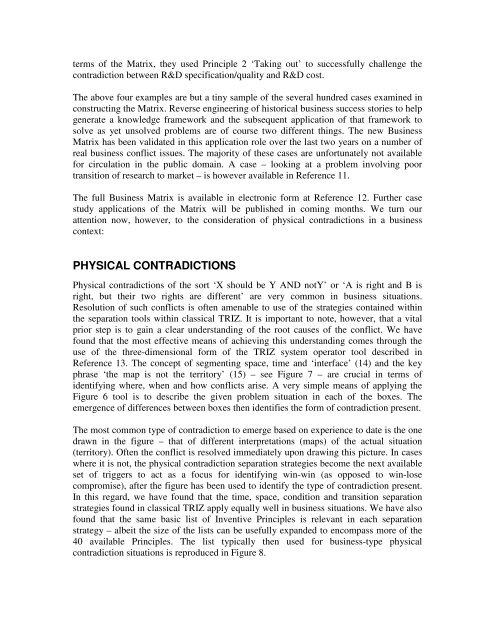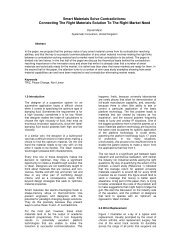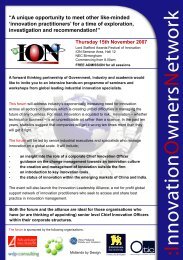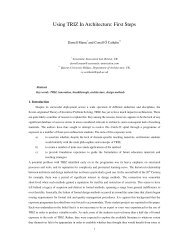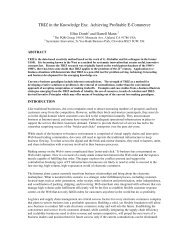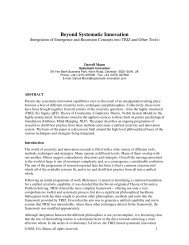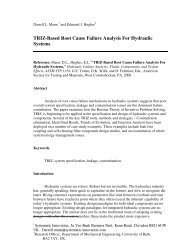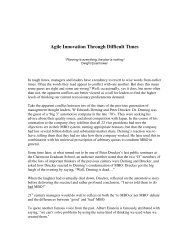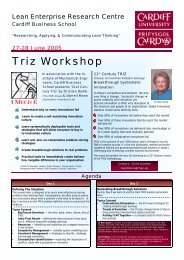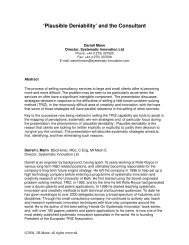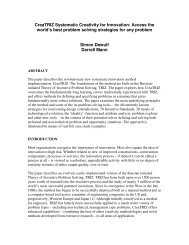systematic win-win problem solving in a business environment
systematic win-win problem solving in a business environment
systematic win-win problem solving in a business environment
Create successful ePaper yourself
Turn your PDF publications into a flip-book with our unique Google optimized e-Paper software.
terms of the Matrix, they used Pr<strong>in</strong>ciple 2 ‘Tak<strong>in</strong>g out’ to successfully challenge the<br />
contradiction between R&D specification/quality and R&D cost.<br />
The above four examples are but a t<strong>in</strong>y sample of the several hundred cases exam<strong>in</strong>ed <strong>in</strong><br />
construct<strong>in</strong>g the Matrix. Reverse eng<strong>in</strong>eer<strong>in</strong>g of historical bus<strong>in</strong>ess success stories to help<br />
generate a knowledge framework and the subsequent application of that framework to<br />
solve as yet unsolved <strong>problem</strong>s are of course two different th<strong>in</strong>gs. The new Bus<strong>in</strong>ess<br />
Matrix has been validated <strong>in</strong> this application role over the last two years on a number of<br />
real bus<strong>in</strong>ess conflict issues. The majority of these cases are unfortunately not available<br />
for circulation <strong>in</strong> the public doma<strong>in</strong>. A case – look<strong>in</strong>g at a <strong>problem</strong> <strong>in</strong>volv<strong>in</strong>g poor<br />
transition of research to market – is however available <strong>in</strong> Reference 11.<br />
The full Bus<strong>in</strong>ess Matrix is available <strong>in</strong> electronic form at Reference 12. Further case<br />
study applications of the Matrix will be published <strong>in</strong> com<strong>in</strong>g months. We turn our<br />
attention now, however, to the consideration of physical contradictions <strong>in</strong> a bus<strong>in</strong>ess<br />
context:<br />
PHYSICAL CONTRADICTIONS<br />
Physical contradictions of the sort ‘X should be Y AND notY’ or ‘A is right and B is<br />
right, but their two rights are different’ are very common <strong>in</strong> bus<strong>in</strong>ess situations.<br />
Resolution of such conflicts is often amenable to use of the strategies conta<strong>in</strong>ed with<strong>in</strong><br />
the separation tools with<strong>in</strong> classical TRIZ. It is important to note, however, that a vital<br />
prior step is to ga<strong>in</strong> a clear understand<strong>in</strong>g of the root causes of the conflict. We have<br />
found that the most effective means of achiev<strong>in</strong>g this understand<strong>in</strong>g comes through the<br />
use of the three-dimensional form of the TRIZ system operator tool described <strong>in</strong><br />
Reference 13. The concept of segment<strong>in</strong>g space, time and ‘<strong>in</strong>terface’ (14) and the key<br />
phrase ‘the map is not the territory’ (15) – see Figure 7 – are crucial <strong>in</strong> terms of<br />
identify<strong>in</strong>g where, when and how conflicts arise. A very simple means of apply<strong>in</strong>g the<br />
Figure 6 tool is to describe the given <strong>problem</strong> situation <strong>in</strong> each of the boxes. The<br />
emergence of differences between boxes then identifies the form of contradiction present.<br />
The most common type of contradiction to emerge based on experience to date is the one<br />
drawn <strong>in</strong> the figure – that of different <strong>in</strong>terpretations (maps) of the actual situation<br />
(territory). Often the conflict is resolved immediately upon dra<strong>w<strong>in</strong></strong>g this picture. In cases<br />
where it is not, the physical contradiction separation strategies become the next available<br />
set of triggers to act as a focus for identify<strong>in</strong>g <strong>w<strong>in</strong></strong>-<strong>w<strong>in</strong></strong> (as opposed to <strong>w<strong>in</strong></strong>-lose<br />
compromise), after the figure has been used to identify the type of contradiction present.<br />
In this regard, we have found that the time, space, condition and transition separation<br />
strategies found <strong>in</strong> classical TRIZ apply equally well <strong>in</strong> bus<strong>in</strong>ess situations. We have also<br />
found that the same basic list of Inventive Pr<strong>in</strong>ciples is relevant <strong>in</strong> each separation<br />
strategy – albeit the size of the lists can be usefully expanded to encompass more of the<br />
40 available Pr<strong>in</strong>ciples. The list typically then used for bus<strong>in</strong>ess-type physical<br />
contradiction situations is reproduced <strong>in</strong> Figure 8.


